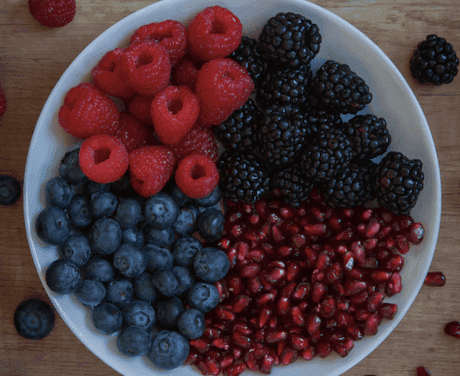Berries and the Ketoflex Nutrition Plan
by Amylee Amos PhD, RDN, IFMCPNutrition
Fruit and the Ketoflex Nutrition Plan
As the summer months approach, the farmers markets and grocery stores are becoming bright with colorful fresh fruits. From sweet and fleshy stone fruits to vibrant berries, the question as to whether or not fruit is a healthful choice when following a structured diet plan remains prevalent on people’s minds, especially when the fruit selection is so appealing. When it comes to eating to promote brain health, fruit tends to be tricky as the Ketoflex Nutrition Plan generally requires a limiting of carbohydrates to achieve a state of mild ketosis. The great news is that fruit can be included in the diet when following the Ketoflex Nutrition Plan and when done properly, can be both a delicious indulgence and provide impressive health benefits.
Our early human ancestors primarily enjoyed fruits in the summer months. Fruit, which is naturally high in sugar, helped the early humans gain weight before winter. This was advantageous and promoted survival. In addition to that, fruit was high in fiber and rich in phytonutrients. The modern fruit we typically see in grocery stores has changed significantly since the days of our early human ancestors. We now have far less variety and most of the options we do have have been selectively bred because they are sweeter and travel better during shipping. However, certain fruits are still lower glycemic, rich in phytonutrients, and thus can be included on a nutrition plan designed for brain health.
Berries are the Best Fruit Option
Berries are an excellent addition to the Ketoflex Nutrition Plan. Berries and other small, dark colored fruits like blueberries, strawberries, raspberries, blackberries, pomegranate, black currants, and cranberries pack a powerful phytonutrient punch. The dark colored pigments contain a class of phytonutrients known as anthocyanins, which have antioxidant and anti-inflammatory properties. Pigments are markers of polyphenols. The blue, purple, and black pigments are associated with improved cognitive performance and neuroprotection. Some of these cognitive benefits include improved neuronal signaling and improved glucose usage. Blueberries have been extensively studied for their cognitive benefits. For example, one randomized control trial showed that 12 weeks of supplementation with blueberry juice resulted in improved memory function compared to placebo. Additionally, the blueberry supplementation group had improvements in depressive symptoms and fasting blood glucose levels (1). While studies like this show the incredible nutritional potential of blueberries, the best option are whole blueberries, rather than juice (in particular, wild organic blueberries).
Portion Size of Berries
Berries make for a delicious dessert. If you’re following the Ketoflex Nutrition Plan, berries are best enjoyed in small portions and should be consumed either following a meal or alongside foods high in protein and fat, such as nuts. Doing this will blunt any potential blood glucose spike and allow for slower absorption of glucose into the cell. For most people following the Ketoflex Nutrition Plan, a serving of berries is approximately ¼ cup. However, to determine the best portion size for you, sign up for our Cognitive Health Program and schedule an appointment with an Amos Institute dietitian.
Ideally, it's best to eat seasonally, so to choose produce when it grows naturally in the area in which you live. Depending on where you are in the world, berries may not be in season right now. However, the health benefits of berries are so vast that it is beneficial to eat them year round. To make this easier, when necessary choose frozen berries which are readily available at many grocery stores and equally nutritious.
References:
Krikorian, R., Shidler, M. D., Nash, T. A., Kalt, W., Vinqvist-Tymchuk, M. R., Shukitt-Hale, B., & Joseph, J. A. (2010). Blueberry supplementation improves memory in older adults. Journal of agricultural and food chemistry, 58(7), 3996–4000. https://doi.org/10.1021/jf9029332